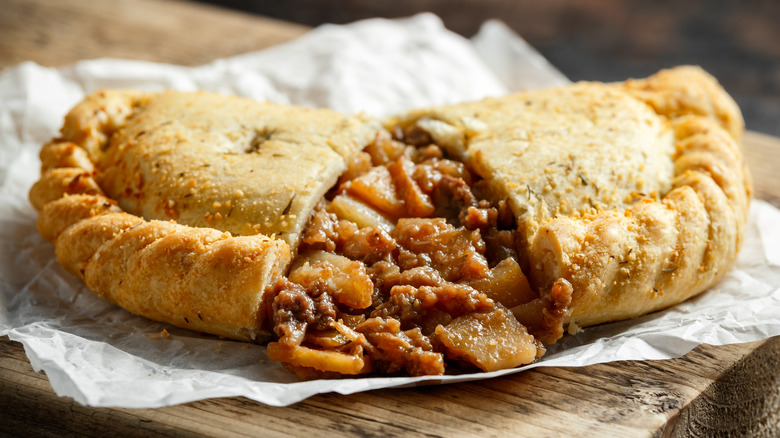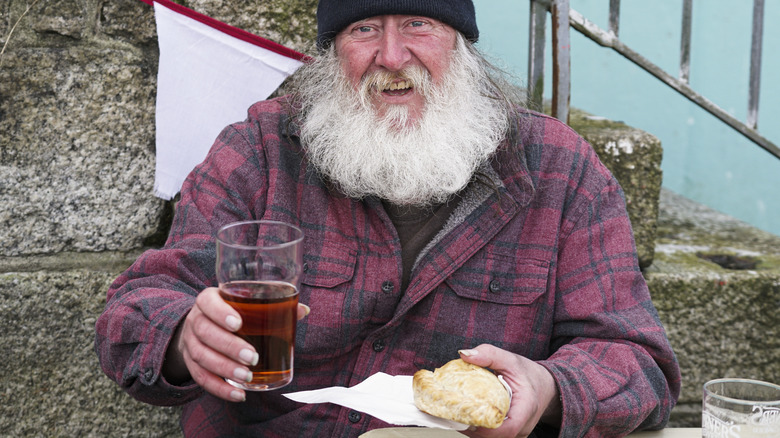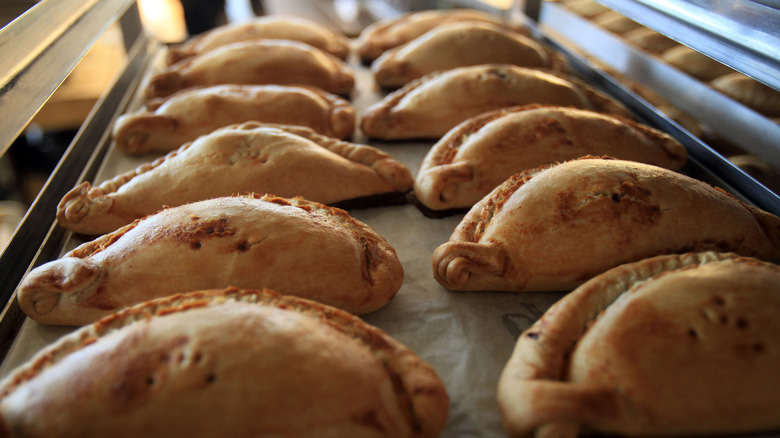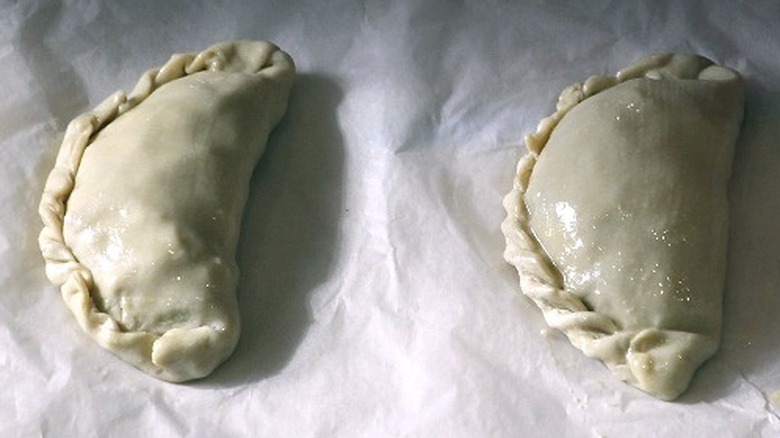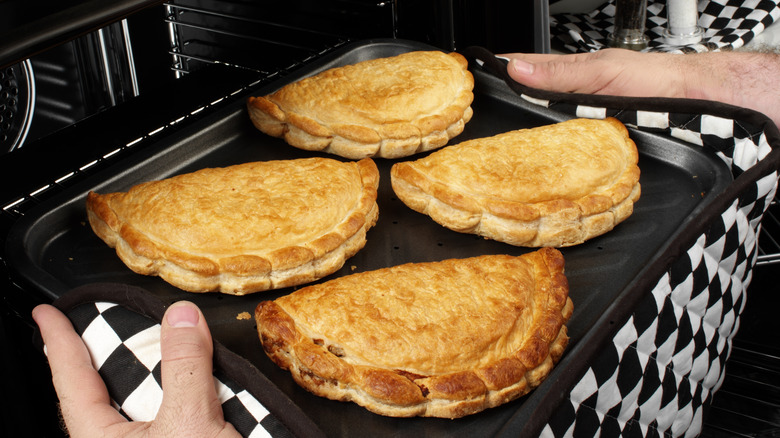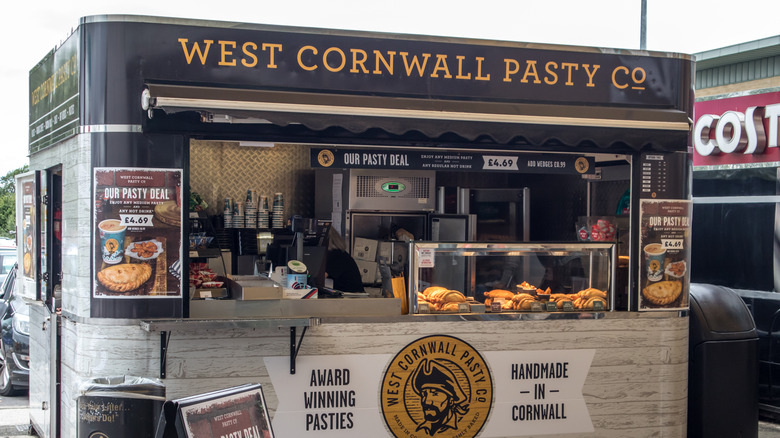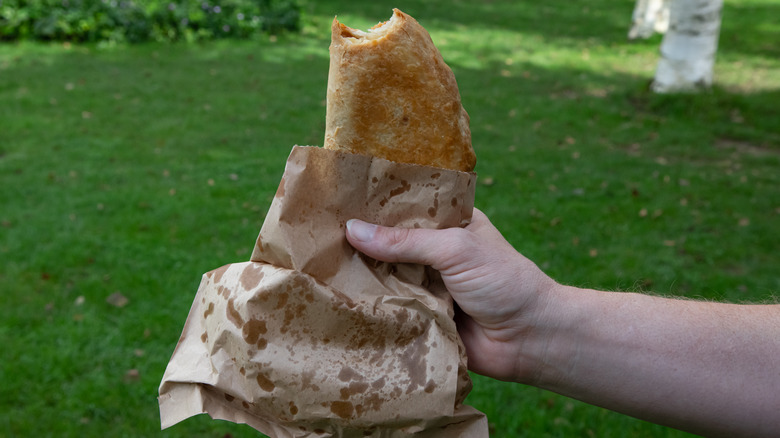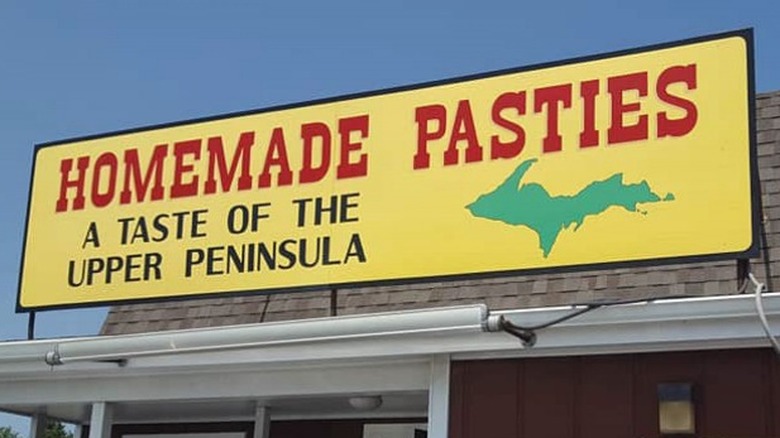What Is A Cornish Pasty And What Does It Taste Like?
If you've ever enjoyed a baked pie pocket that fit perfectly in your hand, its flaky crust folded over and crimped around a savory, hearty filling, then you've had a pasty. According to The Spruce Eats, a pasty is a portable savory pastry filled with meats, vegetables, and seasonings. There are many kinds of pasties, with fillings as diverse as the cooks who lovingly create them, and The Takeout notes that handheld pies like these exist in most cuisines and cultures. You might be tempted here to say that Hot Pockets belong to this family, but those mass-produced, freezer burnt bricks from your college dorm days can't hold a candle to the buttery crusts and well-seasoned, carefully prepared fillings of homemade pasties.
BBC Good Food has an assortment of creative pasty recipes, including ones filled with cheese and Marmite, or leek and potato. But just because you've had a pasty doesn't mean you've had a Cornish pasty. It turns out that this particular handheld pie has a long history, clear provenance, and even a protected status from the government. They're such a British institution that the even the Duke and Duchess of Cornwall, aka Prince Charles and Camilla, attend Cornish pasty celebrations, according to The Daily Mail. But what exactly makes a pasty Cornish?
The history of the Cornish pasty
Per Historic UK, Cornish pasties are most commonly associated with the Cornwall region of southwestern England. The Cornish Pasty Association shares that the earliest documentation of pasties dates to the 1300s, and both What's Cooking America and Pasty Club note that the pies even got a mention or two by Shakespeare, including in "The Merry Wives Of Windsor." But it was the area's long history of tin mining led that led to the local popularity of the dish. Pasties became a food staple of the working classes in the 18th and 19th centuries, especially miners, because their long days underground meant they had to bring lunch in with them.
Miners' wives filled dough with potatoes, other vegetables, and the occasional scrap of meat, then seal the fillings inside to create a semicircle pocket with a crimped edge. What's Cooking America also claims that the pockets had initials carved in them so the laborers knew which pasty was theirs. The side crimp served as a makeshift handle for the miners, so the food wouldn't get contaminated from the miners' hands. Meanwhile, The Cornish Pasty Association says that others swear the pasties were eaten out of cloth or paper bags.
Historic UK also shares that, from the Cornish word for pastry, pasties were often known as hogans, or more slangily as oggies. Women who worked at the mines cooked pasties on small stoves for the men; they called out, "Oggie, oggie, oggie!" down the mine shaft when they were ready and the miners responded with, "Oi, oi, oi!"
The difference between Cornish pasties and other pasties
There are all kinds of pasties and pasty fillings out there, but very specific criteria for a true Cornish pasty. The official Cornish Pasty Association notes that even cherished family recipes can't go too far off the path to be considered authentic Cornish pasties. The meat inside must be chopped or minced beef, and make up at least 12.5% of the filling. Vegetables must be at least 25% of the filling, and must include diced potato, onion, and "swedes," which according to BBC Good Food is a British name for rutabaga. The rules don't stop there: No other meats or vegetables can be used, and the filling must be raw when the pasty is assembled, so it cooks as the pasty bakes. Additionally, Cornish pasties are semi-circle or "D" shaped, and the crimp must be on the side. Fun fact: If they're made by a left-handed baker they're called cock pasties, and those made by right-handers are called hen pasties! The last rule for authentic Cornish pasties is that they be made in Cornwall county, west of the Tamar river in England.
All of these guidelines are part of the Protected Geographical Indication for Cornish Pasties, a status recognized in the E.U. and in England that protects the heritage of the pies and prevents non-Cornwall producers from using the name for copycat pasties. Other examples of protected foods are Waterford blaas (buns from Ireland) and halloumi cheese (from Cyprus) according to Gousto.
How to make Cornish pasties
To make a Cornish pasty that's as authentic as possible (even if you're not in Cornwall), start by making a basic dough to hold the filling, according to BBC Good Food. Their recipe combines cold butter, lard, and ice water with all-purpose flour, either by hand or with a food processor, to make a moderately sturdy mixture. The Cornish Pasty Association says bread flour can also be used to make a stronger dough that holds up well to stretching and filling.
Prepare the filling by combining chopped beef, like skirt steak or chuck, diced potato, diced rutabaga, and diced onion, along with salt, pepper, and any other seasonings you wish in a large bowl. Roll out the dough and cut out 8-inch circles, then divide the filling between the rounds, mounding it in the center of each one. Brush the edges of the circles with beaten egg and fold the pocket over to enclose the filling. Make a tight crimp along the edge to seal it, then brush the top with more beaten egg. The pasties get baked for just under an hour, which cooks the filling and gives the crust a deep, bronzed finish.
The Guardian shares that pasties are best eaten warm and by hand (no forks or knives, please.) While they shouldn't be overwhelmed with a lot of unnecessary sides, pasties are tasty when served with a little spiced chutney, ketchup, pickled cabbage, or mushy peas.
What do Cornish pasties taste like?
The easiest way to nail down the flavor of a Cornish pasty is to look at the ingredients that go into making one. Recipes like the one shared by BBC Good Food have a crust made with both butter and lard. Martha Stewart says that these two fats together create a crust that is both flaky and flavorful. Skirt steak is typically called for in Cornish pasties, and Kitchn says this cut from the chest area of the cow has an "intense beefy flavor." Onions make for a wonderfully savory filling. Potatoes add bulk — the Cornish Pasty Association says waxy types are best because they hold their shape once cooked. Also in the mix are rutabagas, which Food Network says have a slight bitterness, and a flavor like that of turnips and cabbage. All of the vegetables and the skirt steak in the filling are diced to a similar size, so that they cook completely through in the time it takes to bake the pasties.
While taste-testing Cornish pasties, The Guardian noted some important must-haves. For one, blend the filling ingredients well, so that every bit of a baked pasty has an equal proportion of meat, vegetables, and potato. They also share that too much lard in the dough leaves an unpleasant mouthfeel, another reason to use an equal amount of butter. A liberal use of seasoning is crucial too, to avoid an "underpowered" pasty.
How to get your hands on a Cornish pasty
According to the Cornish Pasty Association, the protected status of Cornish pasties mean that they have to be made in Cornwall in order to be the real deal. So if you have plans to spend time in England in the near future, your best bet is to head straight to the source. There are no shortage of shops in Cornwall making the famous treats: Great British Life lists 12 of the best on their site, including St. Ives Bakery, Pip's Pasties, and Hampsons of Hayle. The Cornish Pasty Association also has a list of recommended shops, and some, like Cornish Premier, have pasties available to ship.
If you don't expect to visit Cornwall anytime soon, then bringing Cornwall to you and making your own pasties at home is your next best bet. This recipe from King Arthur Baking Company has all the traditional elements of a true Cornish pasty. Meanwhile, the recipe from the Great British Chefs website includes a bonus: a homemade beefy beer gravy for dunking your pasty. Paul Hollywood shared his signature Cornish pasty recipe on his official website, which includes a pat of butter in the filling for extra moisture inside. The chef and media personality also says that he's heard true Cornish pasties must have 21 crimps along the edge! Nervous about making all those crimps? No worries: Hollywood shows you how in a video for BBC Food.
Are Cornish pasties healthy?
Given that most sources, including The Spruce Eats, describe the Cornish pasty as a comfort food, and that the fact that it's a meat pie wrapped in a pastry made of butter and lard, it's no big surprise that this treat packs a fair share of fat and calories. Yes, there are some vegetables in there too, but that doesn't do much to improve the nutritional stats. For example, the Cornish Pasty recipe shared by Taste Of Home notes that just half of the pie has 556 calories, 10 grams of saturated fat, and 864 milligrams of salt. King Arthur Baking Company's recipe for a whole Cornish Pasty is slightly lighter, but still has 9 grams of saturated fat and 340 milligrams of sodium. However, both recipes have a good amount of protein: 19 grams and 22 grams, respectively. This, combined with the high levels of carbohydrates (46 grams and 55 grams, respectively) explains why Cornish pasties were perfect as the sole source of sustenance for 19th-century miners working long, labor-intensive days.
Nowadays, The Guardian shares that Cornish pasties are more likely to be consumed outside of the mines as the comfort food of choice for late-night snacks, hangover cures, mid-afternoon noshing, or a quick lunch on the go when there's no time for anything else.
How Cornish pasties came to the U.S.
People who traveled from Cornwall to other parts of England and beyond brought pasty recipes with them, and the dish found favor easily. According to What's Cooking America, while they may have lost their Cornish authenticity along the way, pasties proved very popular, and modern versions scan be found in Ireland, Northern England, and even Russia. In the 19th century, when Cornish miners immigrated to America, they headed to Michigan's Upper Peninsula where, as NPR shares, there was a thriving industry of copper mining. The tradition of miners taking pasties with them for their midday meal thrived here as it had in Cornwall, and even caught on with immigrants who came to the area from other countries such as Finland.
Pasties quickly became a permanent part of the identity of Upper Peninsula Michiganders. Interestingly, the meat pies are less known in other parts of the state, and locals often find themselves explaining not only what a pasty is, but how to pronounce the word. (It's pronounced "pass-tee.") Only In Our State recently compiled some of the best places in Michigan to get a pasty, like Uncle Peter's Pasties, Lehto's Pasties, Jean-Kay's, and Muldoon's. Why not give them a visit and see how many you can hold in one hand?
